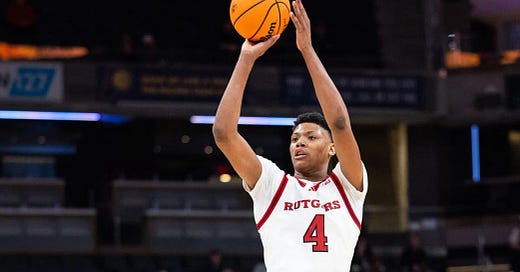Do The Nets Have An Ace Up Their Sleeve?
Under ordinary circumstances, the Nets, barring a risky trade, would have miniscule odds of landing Rutgers star forward Airious “Ace” Bailey at next Wednesday’s NBA Draft.
For much of the run-up to the Draft, Bailey was deemed the consensus third-best prospect. Even if off by a few slots, he presumably would be long gone by the time Brooklyn, with the No. 8 overall pick, is on the clock.
However, the Draft often produces surprises, in the form of both risers and fallers. In Bailey’s case, his speculated slide, at least among NBA analysts who do not actually make picks, appears to be self-engineered.
Far be it for anyone to tell an athlete how to conduct their business, so I’m not going to comment on Bailey’s team’s decisions to forego private workouts or leak morsels to the press about where he wants to play. Well, maybe one thing: The latest is that he’d prefer a team trade up to No. 3, Philadelphia’s slot, to secure his rights. Hello, Captain Obvious. Per Spotrac.com, the rookie scale for the 2025 rookie class calls for a first-year salary difference of approximately $4.3 million between picks three and eight, with the total value difference over a four-year deal some $19.3 million.
Brooklyn, with its talent-deficient roster, development priority, and, yes, New York City address, fits all of Bailey’s alleged prerequisites. He’d come into the league at 19 to a team that currently is slated to have just one other offensive play-driver, and that’s only if Cam Thomas re-signs as a restricted free agent. Not too unlike the situation he just had at Rutgers with pal Dylan Harper running the point plus a bunch of open gym runners. As a Net, Bailey would be free to make mistakes and learn on the job, as opposed to being put in a more pressure-packed situation that plays to win and allocates minutes accordingly, like Philly.
If Bailey were indeed the second coming of Kevin Durant, as his admirers insist, none of this would matter. The Sixers should sprint to the podium to select him.
However, whatever you think of Bailey’s potential, matching him up with an All-Timer like KD does him no service, even if they played a similar style of college ball as freshmen around the same age 18 years apart. At their respective NBA Combine measurements, Durant was over an inch taller, with a four-inch wingspan advantage, and 12 pounds heavier. Their freshman shooting splits were:
Durant: 47.3/40.4/81.6
Bailey: 46/34.6/69.2
There was an acute difference between Texas KD, who was the clear focal point even with future NBA players D.J. Augustin and former Net Damion James on his side, and Rutgers Bailey, who deferred to Harper on most nights. (Note: Bailey dropped 39 and 37 points in a pair of Big 10 games Harper sat out with an injury.) Again, this isn’t a knock on Bailey as much as a reminder of KD’s achievements.
I watched a ton of Rutgers basketball last season (pity me) in the hope the Nets would be in position to grab one of the two stars. Bailey’s detractors aren’t that far off the reservation. Among the harsher scouting reports was the one that claimed he thinks that the ability to make tough shots is more valuable than the ability to create easy ones. Well, he can make some unbelievable shots that portend an elite NBA skill. I just think it’s fairer to say that the highlights don’t show the many misses, nor the decision-making behind the misses. He only converted 36% of his pull-up 2s, 24% of his pull-up 3s, and 42% of his half-court layups, according to Yahoo’s Kevin O’Connor via Synergy. There might be ancillary reasons for such inefficiency, from a lousy Rutgers supporting cast to questionable coaching, but they are part of Bailey’s record.
Bailey has athleticism and bounce, but whether he can add playmaking and defense to those assets is simply a projection, not a factoid. In that sense, he appears to be a bigger version of Thomas, who has to date only shown glimpses of the next-level contributions that would elevate him into an NBA All-Star if he can develop consistency. Since Thomas hasn’t, he remains a polarizing player.
Now, it would be imprudent to only focus on Bailey’s basketball flaws without considering the competition for slots 3-through-8. I still have Duke’s Cooper Flagg and Harper alone in the top two tiers…and then the rest is a bit of a free-for-all. As in beauty in the eyes of the beholder. To suggest that Bailey is an inferior prospect to Duke’s Kon Knueppel, for instance, seems baffling to me. But it is happening within the pundit class (not that any of those distinctions mean anything).
So, as a Nets fan, here’s what to keep in mind regarding Bailey’s Draft Day experience: If he goes top five, as he should, move on to your next best hope. As I discussed in my last post (What Is Marks’ Short-Term Vision For Nets?), trading up historically has resulted in as many or more whiffs than rewards reaped. If anything, the Nets, who haven’t had a lottery pick since 2010, should be looking to add to their lottery pick count, not chase the shiny object.
Depending on how the Draft goes, a Bailey fall to 6 or 7 might fuel an opportunity. Washington and New Orleans might not ascribe the same value to Bailey as Brooklyn has (Nets General Manager Sean Marks attended anywhere from 6-to-12 Rutgers games) or have others higher on their boards anyway. So, it’s possible they could be amenable to trading down without it costing a Brooklyn arm and a leg.
Unless one has insider knowledge, such a scenario seems remote. For all the machinations being thrown about on NBA Twitter, it’s premature to suggest that the Nets have an Ace up their sleeve.



